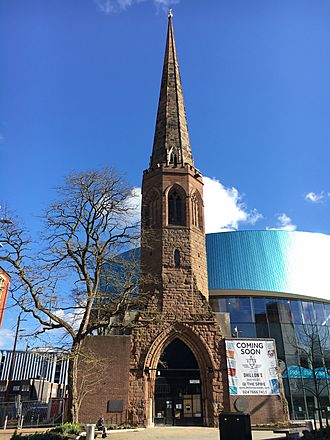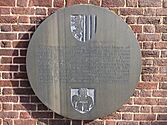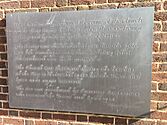Greyfriars, Coventry facts for kids
Quick facts for kids Greyfriars, Coventry |
|
|---|---|

A view of Christchurch Spire
|
|
| Alternative names | Christchurch Spire |
| General information | |
| Type | Spire |
| Address | New Union Street |
| Town or city | Coventry |
| Country | United Kingdom |
| Coordinates | 52°24′21″N 1°30′42″W / 52.40574°N 1.51153°W |
| Construction started | c.1350 |
| Completed | c.1359 |
| Renovated | 1950 |
Greyfriars was a medieval Franciscan priory (a type of monastery) in Coventry, England. The original buildings were lost during the Reformation, a time when many monasteries were closed.
The tall stone spire you see today was once part of a church built in the 1800s. This church was destroyed during an air raid in the Second World War. The spire, also called Christchurch Steeple, is a very old and important building. It is protected as a Grade II* listed building.
Contents
The Greyfriars' Story
Early Days in Coventry
The first time we hear about the Franciscans, or Greyfriars, in Coventry was in 1234. Old records called the Pipe Rolls show that King Henry III gave them wood. This wood was used to build their first small church or prayer house.
Later on, Ranulf de Blondeville, a powerful earl, let them build their home. They built it on his land called Cheylesmore, which was on the southwest side of Coventry.
Growing the Monastery
In 1289, a man named Roger de Montalt gave the friars more land. This helped them make their area bigger. He also helped them close a road that went through their land. But they had to make a new road nearby for people to use.
In 1359, King Richard II gave the Greyfriars permission to take stone. They could use as much stone as they needed from a quarry in the Black Prince's park at Cheylesmore. This stone was for building their monastery.
The king also let their workers freely access the quarry. They could also dig for earth to make walls and plaster. The friars even got a secret gate, called a postern gate, into Cheylesmore park. This was for friars who were sick to get some fresh air. However, they were not allowed to go past the quarry. The head of the monastery, called the warden, kept the key to this gate.
Building the Church
The Franciscan friars usually liked to have simple churches and buildings. But over the years, people who supported them helped build bigger churches on their site. Around 1300, the Hastings family built a chapel next to the friars' church. Many members of their family were buried there.
John Ward, who was the first mayor of Coventry, was also buried in the Greyfriars' church in 1348.
The End of the Monastery
Dissolution of Greyfriars
The original Greyfriars church was located in the center of Coventry. It was a very large church, about 240 feet long and 60 feet wide. It was shaped like a cross, with the spire in the middle.
However, in 1538, the church became a victim of Henry VIII's Dissolution of the Monasteries. This was a time when King Henry VIII closed down many monasteries in England. Most of the Greyfriars church was destroyed, but the tower and spire were saved.
A New Church Rises
Rebuilding the Church
In the early 1800s, Coventry's population was growing. People wanted a new church, so they raised money through donations. The tower and spire were owned by the city of Coventry. In the mid-1820s, the city gave them to the church for rebuilding.
The next few years were spent clearing the land around the spire. Many buildings had been put up there since the monastery was closed.
On March 16, 1830, the first stone for the new church was laid. By the middle of 1832, the rebuilding was finished. On August 3, 1832, a special ceremony was held for the new church. It was named Christ Church, Coventry.
Because of the limited space, the new church was smaller than the original. It was 124 feet long and 55 feet wide. The spire was at one end of the church, not in the middle like before. This meant the front part of the new church was inside the old medieval spire.
Destruction and Legacy
This second church did not last as long as the first one. It was mostly destroyed during a World War II air raid on April 8, 1941. The remaining walls were taken down in the spring of 1950. This left only the old tower and spire standing, just as they had been after the first church was destroyed.



